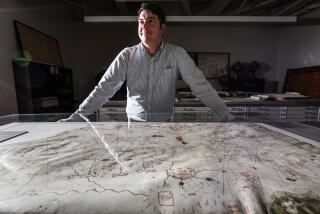THE ATLAS OF ATLASES <i> By Phillip Allen (Abrams: $49.50; 160 pp.) </i>
- Share via
Maps. Can’t live with ‘em, can’t live without ‘em. Some people can follow a gas-station road map to a tree in the forest, others adore them as objects of beauty. This book is sustenance for the objects-of-beauty faction, with its history of medieval and classical map-making, its maps of trade, exploration, discovery and dominance.
Indeed, the ancient Egyptians used maps to help their tax collectors, but the Greeks perfected the science of map-making. In the 3rd Century BC, Erastosthenes of Cyrene measured the circumference of the earth to within some 200 miles of the accepted modern measurements. Much of the book is devoted to the various incarnations of the “Geographica” by Ptolemy, the 2nd-Century Greco-Roman geographer. There is also a long section on the Atlas Minor of Gerardus Mercator, first printed in 1607, with its accompanying version for the “less affluent.” Mercator’s cylindrical projection allowed sailors to steer a course without repeated compass readings. Still, most compelling are the maps with those wonderful words: “UNEXPLORED REGION” or “TERRA INCOGNITA.”
More to Read
Sign up for The Wild
We’ll help you find the best places to hike, bike and run, as well as the perfect silent spots for meditation and yoga.
You may occasionally receive promotional content from the Los Angeles Times.






